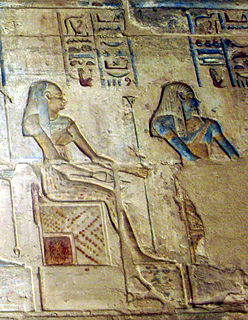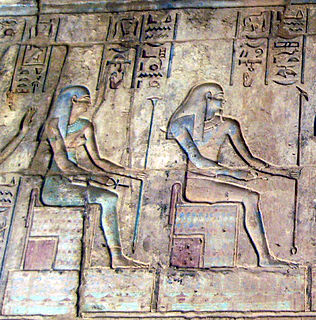The concept of an Ogdoad appears in Gnostic systems of the early Christian era, and was further developed by the theologian Valentinus.

Nu, feminine Naunet, is the deification of the primordial watery abyss in the Hermopolitan Ogdoad cosmogony of ancient Egyptian religion.
The name is paralleled with nen "inactivity" in a play of words in, "I raised them up from out of the watery mass [nu], out of inactivity [nen]". The name has also been compared to the Coptic noun "abyss; deep".

Amunet is a primordial goddess in ancient Egyptian religion.

Kek is the deification of the concept of primordial darkness in the Ancient Egyptian Ogdoad cosmogony of Hermopolis.

The Ennead or Great Ennead was a group of nine deities in Egyptian mythology worshiped at Heliopolis: the sun god Atum; his children Shu and Tefnut; their children Geb and Nut; and their children Osiris, Isis, Seth, and Nephthys. The Ennead sometimes includes the son of Osiris and Isis, Horus. It rose to importance in Dynasties V and VI and remained prominent in Egypt into its occupation by the Macedonian Ptolemaic dynasty established by Alexander the Great's successor in the area, Ptolemy I.
In ancient Egyptian mythology, the fields of Aaru, known also as sḫt-jꜣrw or the Field of Reeds, are the heavenly paradise where Osiris rules once he had displaced Anubis in the Ogdoad. It has been described as the ka of the Nile Delta.
Ḥeḥ was the personification of infinity or eternity in the Ogdoad in Egyptian mythology. His name originally meant "flood", referring to the watery chaos that the Egyptians believed existed before the creation of the world. The Egyptians envisioned this chaos as infinite, in contrast with the finite created world, so Heh personified this aspect of the primordial waters. Heh's female counterpart was known as Hauhet, which is simply the feminine form of his name.

The world egg, cosmic egg or mundane egg is a mythological motif found in the cosmogonies of many cultures that descend from the proto-Indo-European culture and other cultures and civilizations. Typically, the world egg is a beginning of some sort, and the universe or some primordial being comes into existence by "hatching" from the egg, sometimes lain on the primordial waters of the Earth.

Ptolemy the Gnostic, or Ptolemaeus Gnosticus, was a disciple of the Gnostic teacher Valentinius and is known for the Letter to Flora, an epistle he wrote to a wealthy woman named Flora, herself not a gnostic.

This is an index of Egyptian mythology articles.

Nymphaea caerulea, known primarily as blue lotus, but also blue water lily, and sacred blue lily, is a water lily in the genus Nymphaea. Like other species in the genus, the plant contains the psychoactive alkaloid aporphine. It was known to the Ancient Egyptian civilization.
The Hypostasis of the Archons or The Reality of the Rulers is an exegesis on the Book of Genesis 1–6 and expresses Gnostic mythology of the divine creators of the cosmos and humanity.
The Tripartite Tractate "was probably written in the early to mid third century." It is a Gnostic work found in the Nag Hammadi library. It is the fifth tractate of the first codex, known as the Jung Codex. It deals primarily with the relationship between the Aeons and the Son. It is divided into three parts, which deal with the determinism of the Father and the free-will of the hypostatized aeons, the creation of humanity, evil, and the fall of Anthropos, and the variety of theologies, the tripartition of humanity, the actions of the Saviour and ascent of the saved into Unity, respectively.

Theban Tomb TT51 is located in Sheikh Abd el-Qurna, part of the Theban Necropolis, on the west bank of the Nile, opposite to Luxor. It is the burial place of the Ancient Egyptian official, Userhat who was First Prophet of Sethi I, during the 19th Dynasty.

The Heptarchy is a collective name applied to the seven kingdoms of Anglo-Saxon England from the Anglo-Saxon settlement of Britain in the 5th century until their unification into the Kingdom of England in the early 10th century.

Ancient Egyptian creation myths are the ancient Egyptian accounts of the creation of the world. The Pyramid Texts, tomb wall decorations and writings, dating back to the Old Kingdom have given us most of our information regarding early Egyptian creation myths. These myths also form the earliest religious compilations in the world. The ancient Egyptians had many creator gods and associated legends. Thus the world or more specifically Egypt was created in diverse ways according to different parts of the country.
Tatenen was the god of the primordial mound in ancient Egyptian religion. His name means "risen land" or "exalted earth", as well as referring to the silt of the Nile. As a primeval chthonic deity, Tatenen was identified with creation. He was an androgynous protector of nature from the Memphis area, the ancient capital of the Aneb-Hetch nome in Lower Egypt.
The Discourse on the Eighth and Ninth refers to an ancient document, one of three Hermetic texts of the mostly Gnostic Nag Hammadi findings. It is the 30th tractate in the library at large, the sixth in codex VI.

In Egyptian mythology, the Ogdoad were eight primordial deities worshipped in Hermopolis.
Khemenu (Ḫmnw) may refer to:












